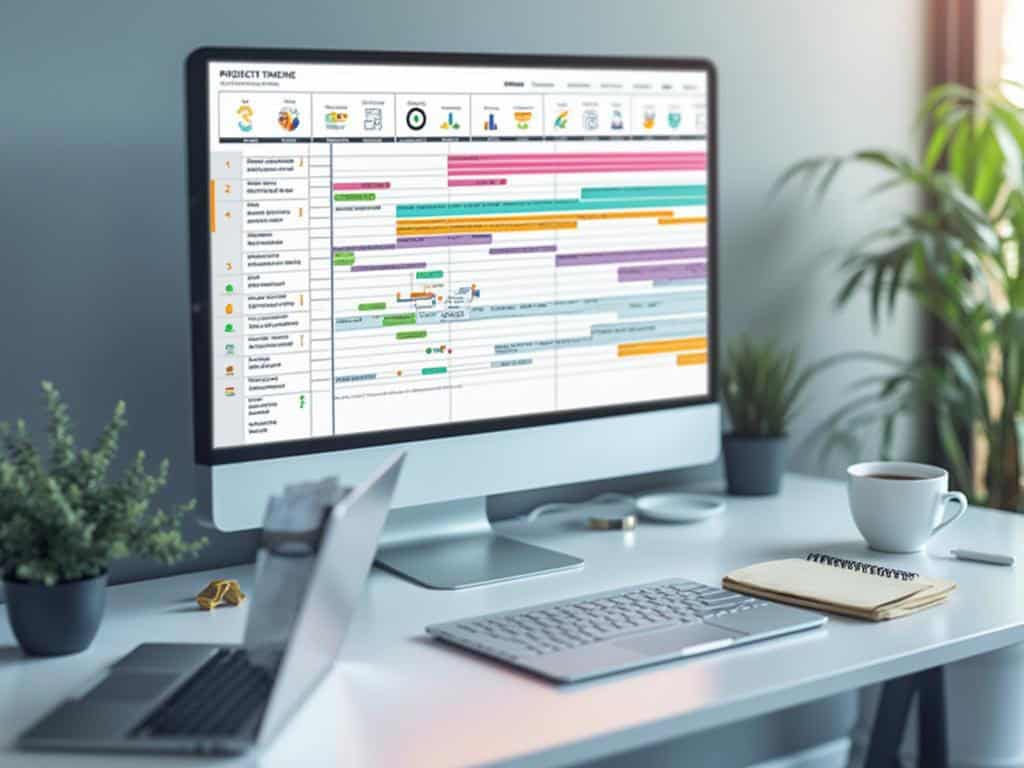
Understanding Project Timelines
A structured roadmap that visualizes task sequences, milestones, and deadlines is what makes the best project timeline. It transforms abstract goals into concrete, time-bound actions by establishing a chronological framework to guide your team through each project phase.
Why Creating the Best Project Timeline Is Critical for Business Success
The best project timeline acts as the backbone of effective project management. It helps you optimize resource allocation, maintain budget control, and deliver results on schedule. Without a well-crafted timeline, your organization risks scope creep, missed deadlines, and resource conflicts that can derail promising initiatives. When properly developed, project timelines provide stakeholders with clear visibility into progress, foster accountability across teams, and allow for proactive problem-solving before small issues become major roadblocks.
A properly constructed timeline doesn’t just track dates—it connects your strategic objectives with daily operations. You’ll find that the best project timeline creates a shared understanding among team members about what needs to happen and when. This alignment reduces confusion and keeps everyone focused on the same goals.
Your timeline should be detailed enough to provide guidance but flexible enough to accommodate unexpected changes. The best project timeline strikes this balance perfectly, giving you both structure and adaptability throughout your project’s lifecycle.
According to the Project Management Institute, 71% of high-performing projects have a well-defined project timeline, which significantly contributes to their success.
Creating the Best Project Timeline
Creating the best project timeline is essential for project success. An effective timeline serves as your project’s foundation, mapping the path from start to finish with clear direction and purpose. This strategic tool sequences tasks, establishes deadlines, and allocates resources appropriately while maintaining team accountability.
Your project’s timeline isn’t just a schedule—it’s a communication tool that sets expectations and helps track progress effectively throughout the entire project cycle. When crafted properly, the best project timeline provides flexibility to adapt to unexpected challenges while keeping everyone focused on delivering results on time.
A quality timeline balances ambitious goals with realistic expectations, incorporating sufficient buffers for potential delays without compromising project momentum. This careful planning prevents the common pitfalls of missed deadlines and scope creep that often derail projects.
The best project timelines don’t remain static documents but evolve as your project progresses. They respond to changing conditions, incorporate feedback, and adjust to new information while maintaining the core project objectives and deadlines.
1. Define Project Scope and Objectives
Creating the best project timeline begins with clearly defining your scope and objectives. Documenting project goals and deliverables helps establish what must be accomplished within your timeline. Start by listing specific, measurable outcomes that will determine project success. When developing the best project timeline, identify all key stakeholders who will influence or be affected by your project. Their input is crucial for setting realistic expectations.
Establish project boundaries and constraints that will impact your timeline, including budget limitations, resource availability, and technical requirements. Consider project constraints and dependencies that might affect your schedule development.
Finally, create a comprehensive project charter that outlines:
- Project purpose and justification
- High-level requirements and deliverables
- Initial timeline estimates
- Preliminary budget projections
- Key stakeholder identification
- Success criteria
This foundation ensures everyone understands the project’s scope before detailed timeline planning begins.
2. Break Down the Project into Tasks
Creating the best project timeline begins with a thorough breakdown of your work. Using a Work Breakdown Structure (WBS) helps you decompose your project into manageable components, making it easier to develop an accurate timeline. When implementing this structure, focus on deliverables rather than activities to ensure all project elements are accounted for.
Task dependencies form the backbone of your best project timeline. Identify which tasks must be completed before others can begin (finish-to-start), which can happen simultaneously (start-to-start), and which relationships might impact your timeline. Visualizing these dependencies through a project dependencies map will reveal potential bottlenecks.
Project milestones serve as checkpoints in your timeline. These significant events mark the completion of major deliverables and help track progress. Effective milestones should be:
- Clearly defined with specific outcomes
- Tied to key project deliverables
- Strategically placed throughout your timeline
- Associated with approval processes when necessary
Finally, document detailed requirements for each task, including resources needed, quality standards, and acceptance criteria. This documentation provides clarity for project collaboration and helps prevent scope creep that could derail your timeline.
Expert Insight: Break down your project into tasks using a Work Breakdown Structure (WBS) to create a manageable timeline. Identify task dependencies and visualize them to spot potential bottlenecks. Thoroughly document task requirements to provide clarity and prevent scope creep, ensuring you stay on track throughout the project’s lifecycle.
3. Estimate Task Durations
Creating the best project timeline requires accurate task duration estimates. Begin by collecting historical data from similar past projects to establish baseline estimates. This approach provides realistic timeframes based on actual experience rather than optimistic guesses.
Consulting subject matter experts is crucial for developing the best project timeline. These specialists can provide insights into technical complexities that might affect duration. Schedule brief interviews with key team members who have hands-on experience with similar tasks to gather their input on realistic timeframes.
The PERT (Program Evaluation and Review Technique) estimation method enhances your project timeline accuracy by using a weighted average of three estimates:
- Optimistic (O): Shortest possible time if everything goes perfectly
- Most likely (M): Normal duration under typical conditions
- Pessimistic (P): Maximum time if significant problems occur
Always incorporate buffer time into your best project timeline to accommodate unexpected challenges. Add approximately 10-15% contingency to critical path activities to prevent cascading delays when surprises occur.
Expert Insight: To create an effective project timeline, leverage historical data for accurate task duration estimates and consult subject matter experts for insights on complexities. Utilize the PERT method for precise calculations and always include 10-15% buffer time for critical tasks to manage unexpected challenges effectively.
4. Assess Resource Availability for the Best Project Timeline
Creating the best project timeline requires careful evaluation of your resource capacity. Begin by listing all required resources including team members, equipment, and materials needed to execute each task. Your project timeline will be more realistic when you account for all resource requirements upfront.
Check resource calendars to understand availability constraints that might impact your project timeline. This includes reviewing team members’ vacation schedules, existing commitments, and public holidays. When planning for the best project timeline, consider that resources are rarely available 100% of the time.
Identify potential conflicts where resources might be overallocated or unavailable. This critical step prevents timeline disruptions later in the project. Look for overlapping assignments or capacity planning issues that could delay task completion.
Plan for resource allocation by determining who will work on which tasks and when. This might involve:
- Negotiating with functional managers for team member time
- Scheduling equipment usage
- Arranging material deliveries to align with your timeline
- Creating a backup plan for critical resources
Proper resource assessment helps prevent cost overruns and ensures your project timeline remains feasible throughout execution.
Expert Insight: To create a realistic project timeline, evaluate resource availability by checking calendars for team members and equipment. Identify potential conflicts and overallocations early to prevent delays. Proper planning and negotiation ensure resources are aligned, reducing the risk of cost overruns and keeping the project on track.
5. Creating a Visual Best Project Timeline
Developing the best project timeline requires a visual representation that communicates your plan effectively. Start by selecting appropriate timeline software that matches your project’s complexity. Popular options include Microsoft Project, Asana, or Smartsheet, each offering unique features for timeline visualization.
When building your Gantt chart, incorporate all the tasks and durations you’ve previously identified. The best project timeline will display tasks in chronological order with clear start and end dates. Follow these steps to create an effective Gantt chart:
- Add all project tasks with their estimated durations
- Set dependencies between related tasks
- Include milestones at key completion points
- Color-code tasks by department or priority level
Next, mark the critical path on your timeline to identify tasks that directly impact your project completion date. The critical path shows which activities have zero float time, meaning any delay will push back your entire project delivery framework.
Finally, highlight dependencies clearly to demonstrate how tasks relate to each other. This helps stakeholders understand workflow sequences and potential bottlenecks in your best project timeline.
Expert Insight: To create an effective project timeline, choose suitable software and build a Gantt chart that visualizes tasks in chronological order with clear dependencies and milestones. Highlight the critical path to identify key tasks that could delay project delivery, and use color-coding for better clarity across departments and priorities.
6. Validate Timeline with Stakeholders
Creating the best project timeline requires thorough validation with all stakeholders to ensure alignment and commitment. When you share your timeline for review, you’re gaining valuable perspectives that can identify potential issues before implementation begins.
Begin by scheduling dedicated review sessions with your team members who will execute the tasks. These frontline workers often have practical insights about how long activities actually take. Your best project timeline will benefit from their real-world experience and help prevent unrealistic expectations.
Next, secure management approval through a formal presentation that highlights:
- Key milestones and deliverables
- Resource allocation plans
- Critical path activities
- Contingency buffers
Address stakeholder concerns promptly and transparently. Some common issues that might arise during timeline validation include:
- Resource conflicts with other projects
- Overly optimistic timeframes
- Missing dependencies between tasks
- Inadequate time for quality assurance
Document all stakeholder feedback systematically, noting what changes were incorporated and which were declined (with reasoning). This creates an audit trail that demonstrates thorough stakeholder engagement and proves valuable during project execution when questions arise about timeline decisions.
7. Implementing Project Timeline Tracking Systems
Once you’ve created the best project timeline, implementing an effective tracking system is crucial for maintaining progress visibility. Setting up proper monitoring tools helps you stay on top of your project’s advancement against the established timeline.
To track progress effectively, choose software that integrates with your project timeline tools. Options like Microsoft Project, Asana, or Jira can help you monitor tasks against your best project timeline benchmarks. These platforms allow you to visualize completion percentages and identify potential delays before they impact your schedule.
Define clear update frequencies that match your project’s pace. For fast-moving projects, daily updates might be necessary, while weekly updates suffice for longer initiatives. Consider these common reporting cadences:
- Daily stand-ups for urgent or short-term projects
- Weekly status meetings for medium-term projects
- Bi-weekly reviews for complex, longer-term projects
Creating standardized project summary reports ensures consistency in communication. Your reporting templates should include timeline variances, milestone status, and resource utilization metrics to maintain transparency with stakeholders and team members.
8. Monitor and Adjust Your Best Project Timeline
Creating the best project timeline is only the beginning—maintaining it requires vigilance and adaptability. You need to continuously track actual progress against planned timelines to ensure your project stays on course. When comparing your best project timeline to actual performance, use visual dashboards that highlight variances at a glance.
Update your timeline regularly based on real-world developments. Aim for weekly updates for fast-moving projects, and bi-weekly for longer initiatives. Your timeline adjustments should reflect:
- Completed tasks and their actual durations
- Newly identified dependencies
- Resource availability changes
- Shifting priorities from stakeholders
Managing change requests properly is critical to maintaining a reliable project timeline. Implement a structured action log to evaluate each request’s impact on your schedule before approval. For each proposed change, assess:
- Timeline implications
- Resource requirements
- Effect on critical path activities
- Stakeholder priorities
Document lessons learned throughout the project to improve future timeline planning. After key milestones, conduct post-implementation audits to identify what affected your best project timeline positively or negatively.
Key Strategies for Project Timeline Success
Creating the best project timeline requires a methodical approach that spans from initial scoping to continuous monitoring. This comprehensive process involves breaking down projects into manageable tasks, accurately estimating durations, assessing resource availability, and creating visual representations. The most effective project timelines incorporate stakeholder validation, implement robust tracking systems, and maintain flexibility for adjustments during execution.
Essential Implementation Steps
- Define clear scope and objectives in a comprehensive project charter
- Create a Work Breakdown Structure (WBS) to decompose the project into manageable components
- Identify task dependencies and establish logical relationships between activities
- Use historical data and expert input to estimate realistic task durations
- Apply the PERT method for more accurate timeline calculations
- Evaluate resource availability and resolve potential conflicts proactively
- Develop visual Gantt charts highlighting the critical path and dependencies
- Validate the timeline with stakeholders and secure management approval
- Implement tracking systems with appropriate update frequencies
- Regularly monitor progress and adjust the timeline as needed
Frequently Asked Questions
- What makes a project timeline “the best”? The best project timeline is realistic, comprehensive, and flexible. It accurately reflects task durations, dependencies, and resource availability while including buffer time for unexpected challenges.
- How often should I update my project timeline? Update frequency depends on project complexity. Fast-moving projects may require daily updates, while weekly or bi-weekly updates are suitable for longer initiatives.
- How do I handle stakeholders who push for unrealistic timelines? Present historical data and expert opinions to demonstrate realistic timeframes. Offer alternatives like phased deliveries or additional resources to meet aggressive deadlines.
- What’s the difference between a milestone and a regular task? Milestones are significant checkpoints marking the completion of major deliverables, while regular tasks are the actual work activities required to reach those milestones.
- How much buffer time should I include in my timeline? Include approximately 10-15% contingency time for critical path activities to accommodate unexpected challenges without derailing the entire timeline.
- What should I do when the timeline starts slipping? Identify the root causes, evaluate impact on the critical path, implement corrective actions, and communicate changes transparently to stakeholders.






